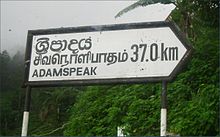- Languages of Sri Lanka
-
Several languages are spoken in Sri Lanka within the Indo-Aryan, Dravidian and Austronesian families. Sri Lanka accords official status to Sinhala and Tamil. The languages spoken on the island nation are deeply influenced by the languages of neighbouring India, the Maldives and Malaysia. Arab settlers and the colonial powers of Portugal, the Netherlands and Britain have also influenced the development of modern languages in Sri Lanka.
Native languages
 A road sign to Adam's Peak in Sinhala, Tamil and English
A road sign to Adam's Peak in Sinhala, Tamil and English
The Sinhala language is spoken by the Sinhalese people, who constitute approximately 70% of the national population and total about 13 million. It utilizes the Sinhala abugida script, which is derived from the ancient Brahmi script. The Rodiya language, a dialect of Sinhala, is spoken by the low-caste community of Rodiyas. The Veddah peoples, totaling barely 300,[citation needed] speak a distinct language, possibly a creolized form of an earlier indigenous language. The Tamil language is spoken by Sri Lankan Tamils, as well as by Tamil migrants from the neighboring Indian state of Tamil Nadu. Tamil speakers number more than 3 million. Additionally, a form of Tamil influenced by Arabic is spoken by the Moor ethnic minority. There are more than 50,000 speakers of the Sri Lankan Creole Malay language, which is strongly influenced by the Malay language.
Languages of foreign influence
English is the mother tongue of approximately 74,000 people, mainly in urban areas, and widely used for official and commercial purposes. Sri Lankan peoples of Portuguese descent, numbering approximately 3,400, speak the Sri Lankan Indo-Portuguese language. The Muslim community in Sri Lanka widely uses Arabic for religious purposes. Until recently the Arwi language, a fusion of Arabic and Tamil, was widely used by the Sri Lankan Moors.
References
Official status 
Widely spoken English · MalayLeast spoken Formerly spoken Extinct 1Rodiya is a dialect of SinhalaCategories:
Wikimedia Foundation. 2010.

